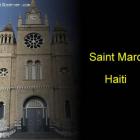ADVERTISEMENT
Dumarsais Estime - Haiti Observer Blog
Dumarsais Estime, Haiti Observer Blog. Read the following articles about Dumarsais Estime
About Verettes, Haiti
The city of Verettes in the Arrondissement of Saint-Marc has a lot to offer. Not only it provides a vibrant and lively night life, it also offers security to its residents and visitors. A number of restaurants, clubs and other entertainment venues are available in Verettes, making music popular in the area. Though it has an active night life, people have nothing to worry about when it comes to their safety. According to reports, the city has an impressive record because it has a very low crime rate.
The city's 51,000 population is divided between two social classes - the rich and the masses. Wealthy families can be recognized by the houses they live in, as most of them reside in homes designed with iron gates and large stone walls. Also, most businesses in the city are owned by rich and well-off families.
Populist President Dumarsais Estime
Dumarsais Estime, Haiti's 33rd president, held office for four years. His presidency is notable because he was the first black leader elected after the U.S. occupation ended in 1934.
Although Estimé married a mulatto elite, his determined educated blacks were to make up the majority of his administration's political appointees. Reversing mulatto elite influence, he championed an education initiative, building schools in poverty-ridden villages and offering advanced teacher-training. This effort created a 45% rise in elementary school attendance.
Dumarsais Estime's agenda included road-construction projects, literacy programs, and improving community services. He also amended the Constitution to provide workers the right to form unions and raised the minimum wage.
Francois Duvalier, Minister of Public Health under Dumarsais Estime
Francois Duvalier who was appointed under the government of Estime, joined the government of President Dumarsais Estime, becoming director general of the national public health service. In 1948 he is appointed as minister of public health and labor.
After the military coup that overthrown the Estime regime on 10 May. 1950, Duvalier returns to his medical career. However, quietly and behind the scenes he begins organizing against the military regime that was in place then. By 1954 he is the central opposition figure and goes underground, hiding inside of the country.
The election of Dumarsais Estime represented a break with the traditional Haitian politic at the time. For one, he was anti-elitist and therefore generally anti Mulatto. The constitution was changed and came into effect in November 1946. He increased the representation of middle-class and lower-class blacks in the public sector and suggested that voodoo be considered as a religion equivalent to Roman Catholicism
Dumarsais Estime, Paul Magloire and Francois Duvalier shaped Haiti
Here is a picture of three major players in the history of haiti: Dumarsais Estime, Paul Magloire and Francois Duvalier
Dumarsais Estime came into power in haiti following a seven-month period of political wrangling. His administration was marked by confrontation with the American government.
The Noiriste government of Dumarsais Estime was noticed by many in the international community. Most Government jobs during his administration, specifically cabinet positions, were reserved for black professionals instead of members of the Mulato elite.
Focus was also on education where he built many provincial schools and expanded training for teachers
Francois Duvalier Reign in Haiti
Francois Duvalier, 40th President of Haiti, began life in Port-au-Prince. Born to a well-to-do family, he earned a medical degree from the University of Haiti. After serving as a political appointee under President Estimé, he ran for the presidency under a populist platform that won support from the Afro-Haitian electorate. He won and began his rule of tyranny, manipulating the Constitution to declare himself "President for Life".
Francois Duvalier tolerated no opposition to his repressive policies. He intimidated his enemies, routinely ordering assassinations, an estimated 30,000 of them. Many educated Haitians fled Haiti, and the island has never recovered its intelligentsia.
Daniel Fignole a Brilliant Labor Leader
Daniel Fignole, born in 1913 in Pestel and raised in grinding poverty, suffered from childhood malnutrition. To escape the poverty of his birthplace, Daniel re-settled in Port-au-Prince and sought an education. He proved to be an excellent student, winning acceptance to a top-tier university in the capital.
During the early 1940s, Daniel Fignole published the leftist, Chantiers, in which he harshly criticized the mulatto elite of Haiti. President Elié Lescot, provoked by Fignolé's attacks, stopped the publication, axed him from his government job, and spied on him.
Indifferent to government actions, Daniel Fignole kept organizing the working-class of Port-au-Prince. They became aware of him as an electrifying orator, motivational writer, and powerful labor leader. It was rumored he could rally mass demonstrations at a moment's notice. In 1947, he headed the Peasant Worker Movement, a tight-knit union comprised of every labor sector.
Paul Magloire, Haiti's 35th president
Paul Magloire, Haiti's 35th president, was born in 1907, heir of a military father. He followed his father's career path, enlisting in the army and rising to Chief of Police in Port-au-Prince.
Paul Magloire played a pivotal role in overthrowing two Haitian presidents, Élie Lescot and his successor, Dumarsais Estimé. President Estimé, in a fruitless effort to draw out his time in office, attempted to amend the Constitution. The mulatto elite aided Magloire in deposing Estimé. Magloire then took the reins of power as President of Haiti.
During his term, Paul Magloire poured money into tourism, Haiti becoming known as a desirable vacation destination for foreign travelers. Imposing a tax on coffee-bean exports, he used the monies for development projects, raising living standards of the impoverished, as well as improving city services. Most notably, he gave the right-to-vote to women. In foreign policy, he forged stronger relations with the Dominican Republic, reversing the violent and unstable history they had shared in the past.
Role, Term of Haitian Presidents from Haiti Independence to 2013
The Haitian government is led by a president, who shares his/her executive power with the prime minister. Once elected by popular vote, the president will run the country for five years. After the term, the president could not run in the next election. He/she has to wait for five years in order to seek a second term. Haiti presidents can only serve for a maximum of two terms.
Not everyone can run for president as there are certain qualifications and requirements to be eligible for the seat. Only candidates with Haitian citizenship by birth can run for the position, as well as those who are at least 35 years of age. Jail sentence, loss of civil rights and lack of property ownership and residency can make a candidate ineligible to assume the position.
The Town of Belladere in Centre Department
Belladère, part of Lascahobas Arrondissement, is a cityship located within Centre Department on the island of Haiti. A population of 78,770 residents, comprised mainly of young boys, form the largest segment of the population. The town contains three sub-divisions, Mathe-Renthe, Riaribes, and Roy-Sec.
Former Haiti President Dumarsais Estime established Belladère in 1948, its name meaning to guard. Considered the crème de la crème of the Central Plateau, its bewitching beauty and proximity to the Dominican-Republic make it an advantageous place for its export market. Elias Piñas, also known as Comendador, is the border-crossing city of the Dominican-Republic, over which Haitian day-laborers travel to seek jobs. Transportation means used to cross over include jitney buses, donkey trains, and agriculture export trucks.
Paul Magloire was Haitian Military ruler
Magloire was born on July 19, 1907 in Cap Haitien, Haiti. He gained his leadership skills from his mother, General Magloire Rose. He joined the Haitian army in 1930 but due to his hard work he was promoted to Police Chief of Port-au- Prince in 1944. In 1946 he took part in coup against President Elie Lescot. His ability to fight for his rights made him to become the president in 1950 after removing President Dumarsais Estime from power.
He was a great leader who improved tourism in Haiti through maintaining good relations with US and European tourists. Magloire used the money the country got from coffee export to develop Haiti by repairing towns, building roads, public building and dam building. He was a social being who cerebrated and held parties with Haitians always. He empowered women's suffrage institutions.
Our objective is to share with you news and information about Haiti and the people of Haiti. Traditions, habits and the way we were or grew are alive in this site. We highly recommend that you Subscribe to our Newsletter and also share with us some of the things that are memorable and made us unique people.

 Black Friday Shopping Season
Black Friday Shopping Season  Haiti tech Summit
Haiti tech Summit  Thomassique, Haiti
Thomassique, Haiti  Battle of Vertieres
Battle of Vertieres  Saint Marc, Haiti
Saint Marc, Haiti